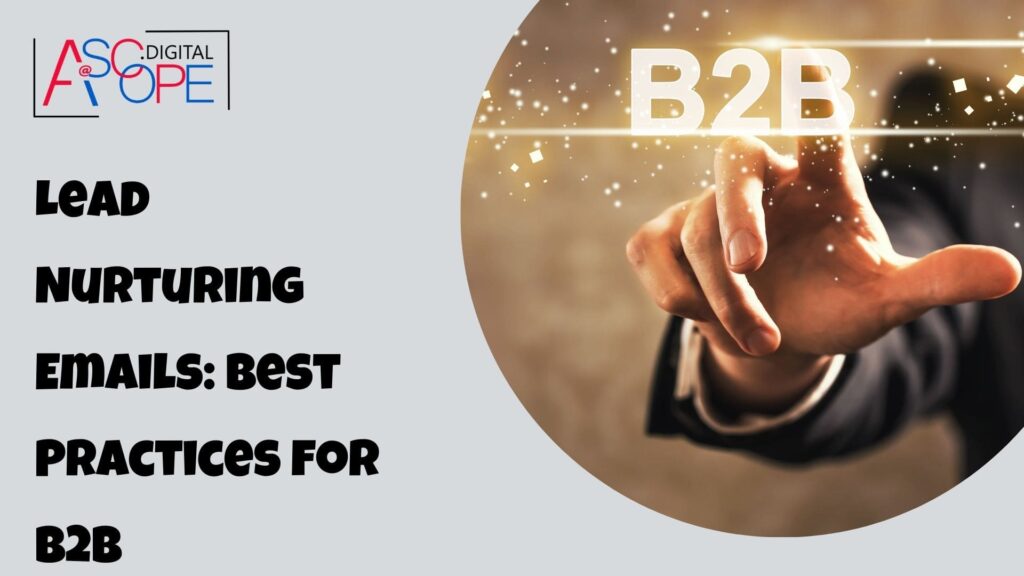In the ever-evolving landscape of B2B marketing, lead nurturing has emerged as a crucial strategy for converting prospects into loyal customers. One of the most effective tools in this process is the lead nurturing email. These emails are designed to build relationships with potential clients, educate them about your products or services, and ultimately guide them down the sales funnel. In this blog, we will explore the best practices for creating and implementing lead nurturing emails in a B2B context.
Understanding Lead Nurturing
Before diving into the best practices, it’s essential to understand what lead nurturing entails. Lead nurturing is the process of developing relationships with buyers at every stage of the sales funnel and through every step of the buyer’s journey. It focuses on listening to the needs of prospects and providing the information and answers they need.
The Importance of Lead Nurturing Emails
Lead nurturing emails are particularly important in B2B marketing because the sales cycle is often longer and more complex than in B2C markets. These emails help in:
- Building Relationships: Establishing a connection with potential customers.
- Educating Prospects: Providing valuable information that can help in making informed decisions.
- Maintaining Engagement: Keeping your brand top-of-mind throughout the sales cycle.
- Driving Conversions: Encouraging prospects to take the next step towards becoming customers.
Best Practices for Lead Nurturing Emails
1. Segment Your Audience

Segmentation is the foundation of effective lead nurturing. Not all leads are the same, and they should not be treated as such. By segmenting your audience based on criteria such as industry, company size, buying behavior, and stage in the sales funnel, you can tailor your emails to address the specific needs and pain points of each group.
- Demographic Segmentation: This includes factors like age, gender, job title, and location.
- Firmographic Segmentation: This includes company size, industry, and revenue.
- Behavioral Segmentation: This includes website interactions, email engagement, and past purchases.
- Psychographic Segmentation: This includes interests, values, and lifestyle.
2. Personalize Your Emails
Personalization goes beyond simply addressing the recipient by name. It involves using the data you have on your leads to create highly relevant content. Personalized emails can lead to higher open and click-through rates. Here are some ways to personalize your lead nurturing emails:
- Dynamic Content: Use dynamic content blocks to display different content based on the recipient’s preferences or past behavior.
- Personalized Recommendations: Suggest products or services based on the recipient’s previous interactions.
- Tailored Messaging: Adjust your message to reflect the recipient’s stage in the buyer’s journey.
3. Provide Value with Every Email
Your lead nurturing emails should always provide value to the recipient. This can be in the form of educational content, industry insights, or solutions to their pain points. The goal is to position your brand as a trusted advisor rather than just another vendor. Some content ideas include:
- Whitepapers and Ebooks: In-depth resources that address common challenges in your industry.
- Case Studies: Real-world examples of how your product or service has helped other businesses.
- Webinars and Videos: Engaging formats that offer valuable information and insights.
- Blog Articles: Relevant and informative articles that address common questions and concerns.
4. Use a Multi-Touch Approach
A single email is rarely enough to nurture a lead effectively. A multi-touch approach involves sending a series of emails over time, each building on the previous one. This approach helps in gradually guiding the prospect through the sales funnel. Here’s an example of a multi-touch email sequence:
- Welcome Email: Introduce your brand and set the expectations for future communications.
- Educational Email: Provide valuable information that addresses the prospect’s pain points.
- Case Study Email: Share a relevant case study that demonstrates the value of your product or service.
- Product/Service Email: Highlight the features and benefits of your product or service.
- Testimonial Email: Share testimonials from satisfied customers.
- Call-to-Action Email: Encourage the prospect to take the next step, such as scheduling a demo or consultation.
5. Optimize for Mobile
With an increasing number of people checking their emails on mobile devices, it’s crucial to optimize your lead nurturing emails for mobile. Here are some tips:
- Responsive Design: Use a responsive design that adapts to different screen sizes.
- Short Subject Lines: Keep subject lines short and to the point to ensure they are fully visible on mobile devices.
- Clear and Concise Content: Keep your email content clear and concise to make it easy to read on smaller screens.
- Prominent Call-to-Action: Make sure your call-to-action buttons are large enough to be easily tapped on mobile devices.
6. Test and Analyze
Testing and analyzing your lead nurturing emails is essential for continuous improvement. A/B testing allows you to compare different versions of an email to see which one performs better. Key elements to test include:
- Subject Lines: Test different subject lines to see which one has a higher open rate.
- Email Content: Test different types of content to see which one resonates more with your audience.
- Call-to-Action: Test different call-to-action buttons and placements to see which one generates more clicks.
Analyzing your email performance metrics, such as open rates, click-through rates, and conversion rates, can provide valuable insights into what’s working and what’s not. Use these insights to refine your email strategy and improve your results over time.
7. Maintain Consistency

Consistency is key in lead nurturing. Your emails should have a consistent tone, style, and branding. This helps in building trust and recognition with your prospects. Here are some tips for maintaining consistency:
- Brand Voice: Use a consistent brand voice that reflects your company’s personality and values.
- Design: Use consistent design elements, such as colors, fonts, and imagery, in all your emails.
- Frequency: Maintain a consistent email frequency to keep your prospects engaged without overwhelming them.
8. Automate Your Lead Nurturing
Automation is a powerful tool for lead nurturing. It allows you to send the right message to the right person at the right time, without manual intervention. Marketing automation platforms can help you create automated email workflows based on triggers, such as:
- Website Activity: Send targeted emails based on the recipient’s behavior on your website.
- Email Engagement: Send follow-up emails based on the recipient’s interaction with previous emails.
- Stage in the Sales Funnel: Send relevant content based on the recipient’s stage in the buyer’s journey.
9. Align Sales and Marketing
Effective lead nurturing requires alignment between sales and marketing teams. Both teams should work together to define the criteria for qualified leads, develop a shared understanding of the buyer’s journey, and create a seamless handoff process. Here are some tips for aligning sales and marketing:
- Regular Meetings: Hold regular meetings between sales and marketing teams to discuss goals, strategies, and progress.
- Shared Goals: Set shared goals and metrics to ensure both teams are working towards the same objectives.
- Feedback Loop: Establish a feedback loop where sales can provide feedback on the quality of leads generated by marketing.
10. Follow-Up and Follow Through
Following up with leads is crucial in the lead nurturing process. After sending a series of nurturing emails, it’s important to follow up with a personal touch. This can be in the form of a phone call, a personalized email, or a meeting request. The goal is to build on the relationship established through your nurturing emails and move the prospect closer to a decision.
- Personal Follow-Up: Reach out personally to high-potential leads to discuss their needs and how your solution can help.
- Timely Follow-Up: Follow up in a timely manner after key interactions, such as attending a webinar or downloading a resource.
- Value-Added Follow-Up: Provide additional value in your follow-up, such as offering a free consultation or providing exclusive content.
Boosting Sales with Lead Nurturing Emails: Best Practices for B2B
Lead nurturing emails are a crucial tool for B2B businesses aiming to convert potential customers into loyal clients. To maximize sales, it’s essential to follow best practices that engage and guide leads through the sales funnel. Start by segmenting your email list to tailor content to the specific needs and interests of different groups. Personalize your emails with relevant information and offers that address the unique pain points of your leads. Use a mix of educational content, case studies, and testimonials to build trust and demonstrate the value of your product or service. Incorporate strong calls-to-action that encourage leads to visit your website, thereby increasing website traffic and driving them closer to making a purchase. Consistently analyze and optimize your email campaigns based on performance metrics to ensure they effectively contribute to your sales goals. Thus, boosting sales with lead nurturing email is a good way to improve traffic and sales for your website. Read more on the other reasons why you website isn’t getting traffic.
Conclusion
Lead nurturing emails are a powerful tool for B2B marketers. By following these best practices, you can create effective email campaigns that build relationships, educate prospects, and drive conversions. Remember to segment your audience, personalize your emails, provide value, use a multi-touch approach, optimize for mobile, test and analyze, maintain consistency, automate your lead nurturing, align sales and marketing, and follow up with your leads. With a well-executed lead nurturing email strategy, you can turn prospects into loyal customers and drive long-term business growth.


